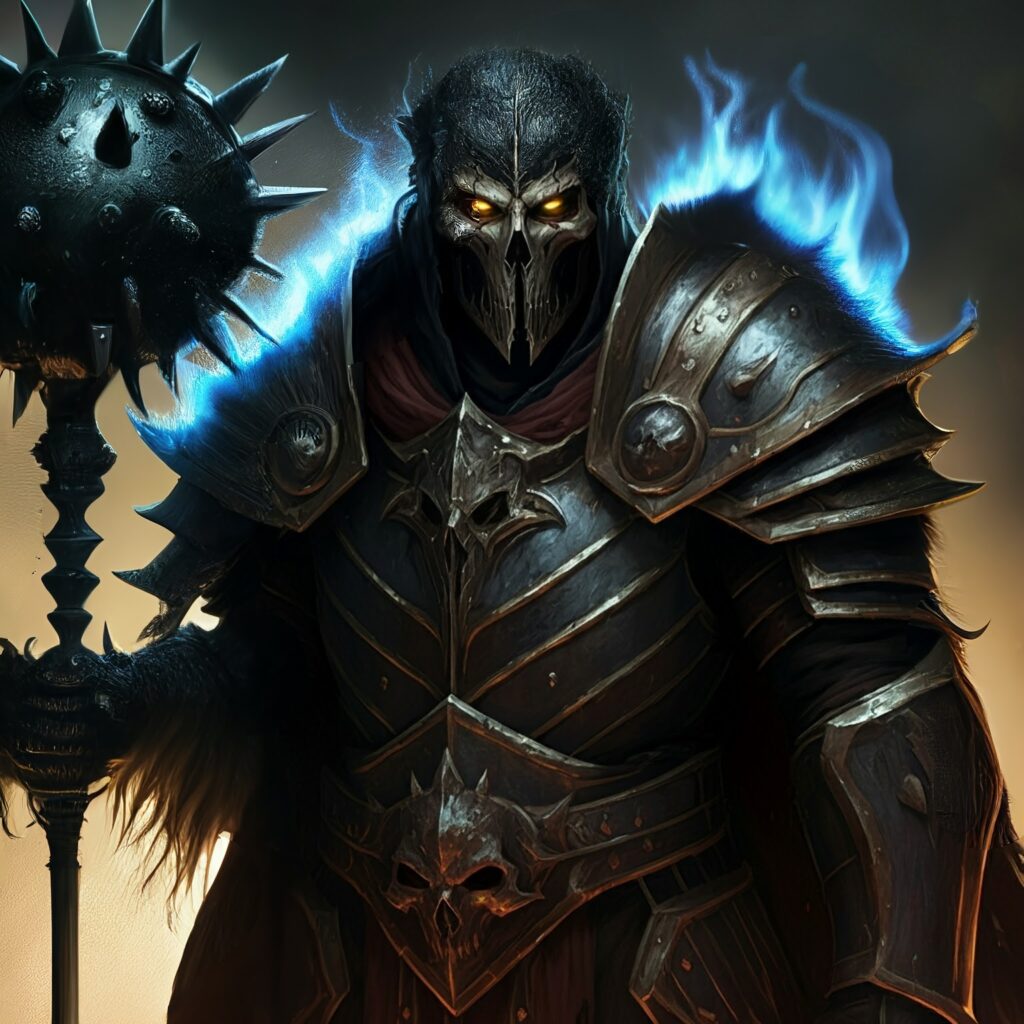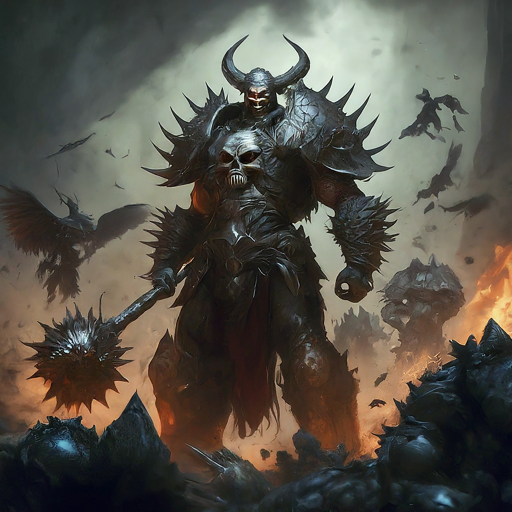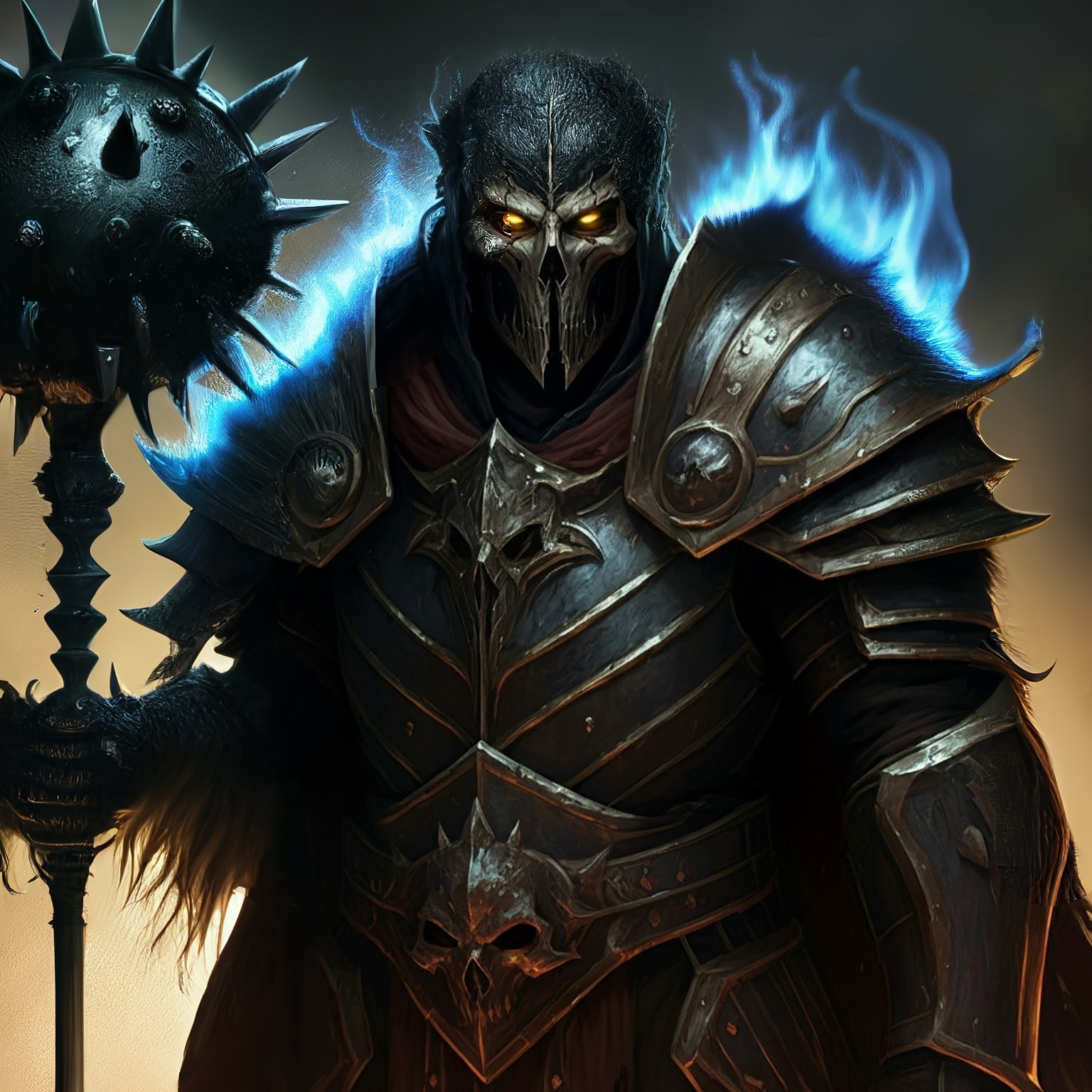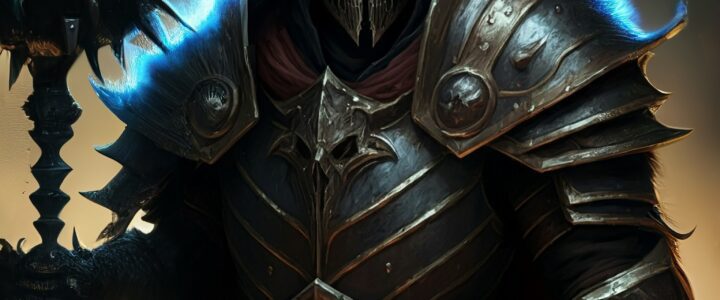- Title: The Tyrant
- Domain: Oppression and Slavery
- Alignment: Lawful Evil
Description:
Kharvos is the ruthless god who represents the iron fist of oppression and the subjugation of the weak. He is the embodiment of tyrannical rule, enforcing his will through sheer power and unyielding control. Kharvos believes that order can only be maintained through the absolute dominance of the strong over the weak, and he seeks to impose his will on all who oppose him. His followers are often those who crave power and control, from cruel kings to brutal warlords, all seeking to maintain their rule through fear and oppression. Kharvos is a god who demands loyalty and obedience, rewarding those who serve him with the power to crush their enemies and enforce their rule.
Physical Appearance:
Kharvos appears as a towering figure clad in dark, heavy armor, his face hidden behind a fearsome mask that resembles a skull. His eyes burn with a cold, malevolent light, and his presence radiates an aura of authority and fear. He carries a massive, spiked mace, a symbol of his brutal power and the force he uses to crush those who dare defy him. His voice is deep and commanding, capable of instilling terror in even the bravest of souls. Kharvos is often depicted with chains draped across his body, representing the enslavement and oppression of those under his rule.
Symbols and Colors:
Kharvos is symbolized by an iron crown or a clenched fist, representing his absolute authority and the power he wields over others. His primary colors are black and dark gray, symbolizing the shadow of his rule and the iron will he imposes on the world.
Sacred Animal:
The bull is sacred to Kharvos, symbolizing strength, power, and the relentless force used to subjugate others. The bull, often depicted with chains or a yoke, represents both the strength of Kharvos and the burden of oppression he places on those under his dominion.
Worship and Rituals:
Kharvos’s followers include tyrants, slave masters, and those who rule through fear and oppression. His rituals often involve acts of dominance and displays of power, such as public executions, displays of strength, or the breaking of those who oppose his rule. Blood offerings are made to Kharvos to seek his favor in battle or to ensure the loyalty of one’s subjects. Temples dedicated to Kharvos are fortresses of power, often located in the heart of oppressive regimes, where his followers gather to plot and enforce their rule.
Temples and Shrines:
Temples to Kharvos are imposing structures, often built like fortresses or prisons, with thick walls and iron gates. These temples are designed to inspire fear and awe, with statues of Kharvos standing over chained figures representing the subjugated. Shrines to Kharvos can be found in places of power, such as thrones or war rooms, where leaders and rulers seek his guidance to maintain their control over their subjects.
Legends and Myths:
One of the most infamous legends associated with Kharvos is the tale of the “Iron Gauntlet,” a powerful artifact said to have been created by Kharvos himself. The Iron Gauntlet grants its wearer unparalleled strength and the ability to bend others to their will, but at the cost of their humanity. The wearer is slowly consumed by the power of the gauntlet, becoming a tyrant in both mind and body, unable to remove the gauntlet once it has been donned.
Role in Nathakra:
In Nathakra, Kharvos represents the darker side of order and control. While Vorithas revels in the chaos and destruction of war, Kharvos seeks to establish an iron-fisted rule over the world, where the strong dominate the weak without question. His influence is felt in every act of oppression and every chain that binds a slave. Kharvos’s desire to control all aspects of life in Nathakra puts him at odds with Vorithas, whose chaotic nature disrupts the strict order Kharvos seeks to impose. This rivalry has led to numerous conflicts between their followers, with each god trying to outmaneuver the other in their quest for power.
Rivalry with Vorithas:
Kharvos and Vorithas are natural enemies, each representing opposing aspects of power. While Vorithas thrives on chaos and destruction, Kharvos seeks to establish a rigid order where he alone holds absolute control. Their rivalry is fueled by their conflicting desires, with Kharvos viewing Vorithas’s chaotic nature as a threat to the stability he wishes to impose on Nathakra. The two gods are often depicted in epic battles, with neither willing to yield to the other’s vision of power.
Desire for Zarathra:
Kharvos harbors a deep, covetous desire for Zarathra, the Mistress of Pain and the spouse of his rival, Vorithas. He sees in Zarathra a kindred spirit, someone who revels in the torment and subjugation of others, and he longs to make her his own. This desire further intensifies his rivalry with Vorithas, as Kharvos seeks to claim both Zarathra and her domain of suffering for himself. His followers believe that if Kharvos were to win Zarathra’s favor, the combined power of their domains would make him unstoppable, allowing him to impose his tyrannical rule over all of Nathakra.


Discover more from The World of Nathakra
Subscribe to get the latest posts sent to your email.

